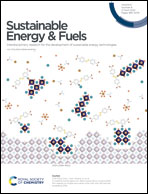A multifunctional ligand for defect passivation of perovskite film realizes air-stable perovskite solar cells with efficiencies exceeding 20%†
Abstract
In this paper, we report commercially available 6,6′-dithiodinicotinic acid (dtdn), a multifunctional ligand, as an additive for application in efficient perovskite solar cells (PSCs). The functional reactive sites of dtdn—carboxylic acid groups, sulfur atoms, and pyridyl nitrogen atoms—interacted with the perovskite (CH3NH3PbI3) components through hydrogen bonding and Lewis acid/base interactions, thereby minimizing non-radiative recombination and passivating the defects of the perovskite. We fabricated p–i–n PSC devices having the structure glass/indium tin oxide (ITO)/NiOx/CH3NH3PbI3 (with or without an additive)/PC61BM/BCP/Ag. The dtdn-passivated perovskite exhibited enhanced carrier transport and lifetimes, thereby realizing high-performance PSCs. Furthermore, we introduced urea as an additional additive to vary the grain sizes in the perovskite film. Using this approach, we obtained an air-stable PSC with improved power conversion efficiency from 16.76 to 20.64%, relative to that of the control device.



 Please wait while we load your content...
Please wait while we load your content...